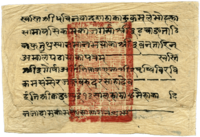User:Pdacortex/sandbox
This article needs more links to other articles to help integrate it into the encyclopedia. (November 2012) |
Nepalese handmade lokta paper is made from the fibrous inner bark of high elevation evergreen shrubs of primarily two species of Daphne (Greek: meaning "Laurel"): Daphne bholua and Daphne papyracea. And are known locally in Nepal as lokta bushes.

Lokta bushes proliferate in open clusters or colonies on the southern slopes of Nepal’s Himalayan forests between 1,600 and 4,000 m (c.5,250–13,000 ft).
Historically the handcrafting of lokta paper occured in the rural hills of Nepal, most notably in the Baglung District. The long-lasting qualities and resistance to insects and mildew made lokta paper popular for the recording government records and religious texts.[1] Today raw lokta paper is produced in more than 22 districts but the finished product of the lokta bush is produced only in Kathmandu Valley and Janakpur.[2]
Paper Making process[edit]

Making process of Lokta paper begins by cleaning the bark of Lokta with sharp knives and chopping it into small pieces. These are then soaked in plain water for 5–6 hours and then cooked in a soaking solution of hot water and soda for 1–2 hours. Then it is washed in cold water. Finally, it is hammered and converted into pulp. The pulp is then poured into wooden frames for drying into sheets of paper and are dried under the sun. The usual size of the Lokta paper is 50 x 76 cm, with several weight such as 40 gr, 20 gr, 10 gr and 5 gr.
Lokta Paper can be preserved for very long period of time. The long fibrous handmade paper is prized for its attractive texture, its durability, strength and its resistance to germs and insects like silverfish, paper crawlers etc. The papers made from Lokta are non-perishable in the water. These papers are easy to dye in water with colors and are ideal in production without using any machines in the entire process.
Lokta can also be used in paper conservation as Japanese tissue.
References[edit]
- ^ [http://www.positivedeviance.org/pdf/publications_other/BIGGSNepalpaper.pdf Social Responsibility in the Growing Handmade Paper Industry of Nepal]
- ^ Brand identity eludes Lokta Paper at home

